Diarrhoea defined as the occurrence when intestinal fluids are not absorbed appropriately in the intestines. Anything that affects the intestine’s ability to absorb fluid may result in diarrhoea. Diarrhoea is one of the sympathetic condition occur in so many infectious and non infectious diseases in livestock. It is the chief symptom of gastritis, enteritis sometimes both. Diarrhoea is pathological condition of gastroenterological affections. Livestock maintain by health by food and environment condition. Because of sudden change in health condition and sudden change in environmental conditions also predisposing factor for diarrhea. Diarrhoes with frank blood indicates large intestine affection and diarrhoes with digested blood indicates stomach or small intestine affections.
Predisposing factors
Change in diet, change in climatic condition, immature green fodder, contaminated feed and water, stress, transport, improperly stored feed, overcrowding in the farm, unhygienic practices in the farm and faeco-oral contamination. Diarrhoea occurs in the following conditions such as physiological and pathological conditions
Etiologic agent
Mainly divided into infectious and non infectious agent
Infectious agent
Bacterial agent
- Cattle: Escherichia coli, Salmonella, Clostridium perferingens type B,C and D, Proteus, Pseudomonus spp. Mycobacterium paratuberculosis. Enterobacteriosis, Comphylobacterioisis. Shigella spp.
- Sheep and goats: Escherichia coli, Salmonella, clostridium perferingens
Viral agent
- Cattle: Rota virus, Corona virus, Bovine virus diarrhoea, Bovine mucosal disease.
- Sheep and goats: rota virus, corona virus, PPR,
Parasitic origin
- Cattle:Tape worm, round worm and Flukes.
- Sheep and goats: Round worms, Flat worm and Tape worms.
Protozoal agent
- Cattle: Eimeria spp, B coli, Giardia spp. and cryptosporidium spp.
- Sheep and goats: Eimeria spp. And cryptosporidium spp. And Giardia
Non infectious agents
- Nutritional causes.
- Gastrointestinal worm load.
- Sudden change in the diet.
- Over feeding of immature green feeds, concentrates.
- Ruminal acidosis.
- Simple indigestion.
- In young animals, inadequate feeding of colostrum, milk
- Stress, allergies.
- Poor hygiene.
- Mycotoxin contaminated food.
Clinical signs
Diarrhoea usually the clinical signs of different etiological agent, based on the colour, consistency odour we can tentative diagnosis the etiological agent. The farm animals that to especially calf and sheep and goats kids were prone to diarrhoea due to immunosuppression.Watery diarrhoea along with drooling saliva observed in calves due to rota viral infection. Within 24 hr of calf birth this virus can be infection to calf. The faeces is yellowish to greenish in colour. In Corona virus infection, diarrhoea observed within 5 days in calves, faeces will be clear mucus content resembles the white of an egg. In Bovine viral diarrhoea, the cattle shows diarrhoea along with other signs such as ulcers on tongue,lips, incoordination, stumbling, Tremors in shown in calves. In adults fever, occulonasal discharge, lethargy and inappetance. In Colibacillosis, causes by the E coli, the bacteria present in the intestine and due to stress it will multiply in the intestinal mucosa and produce the toxin and cause the diarrhoea . These toxins causes sever enteritis and death occurs due to septicaemia. It is more occurs in young ones compare to adults animals. This bacteria sheds in the faeces and causes sever outbreak to the farms. The mainly clinical signs include white pasty and foul smelling diarrhoea with sever dehydration.
The other bacteria caused diarrhoea was Salmonella, it produces endotoxin and cause enteritis due to multiplication in the intestinal epithelium and reach into the blood stream and cause severe diarrhoea to the animals. The diarrhoea occurs with blood and fibrin or sometimes yellow clots observed in the faeces. In Pulpy kidney disease, sometimes diarrhoea observed in the animals. Shooting diarrhoea is classical sign of John’s disease. In Coccidiosis blood mixed diarrhoea observed along with sever dehydration. In worm load infestation, foul smelling pasty like faecal output observed. In sometimes, simple indigestion and over earring causes diarrhoea. In ruminal acidosis, loose greenish diarrhoea occurs after treatment. In parasitic origin diarrhoea with mucus mixed faeces with foul smell will be seen.
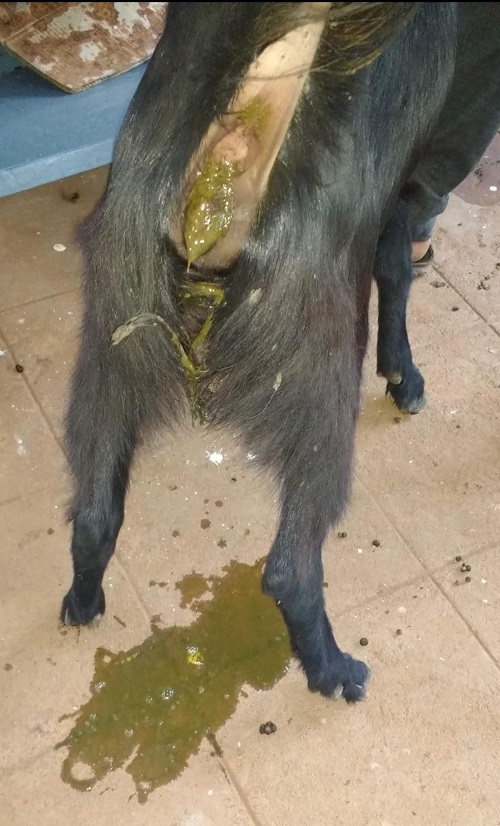
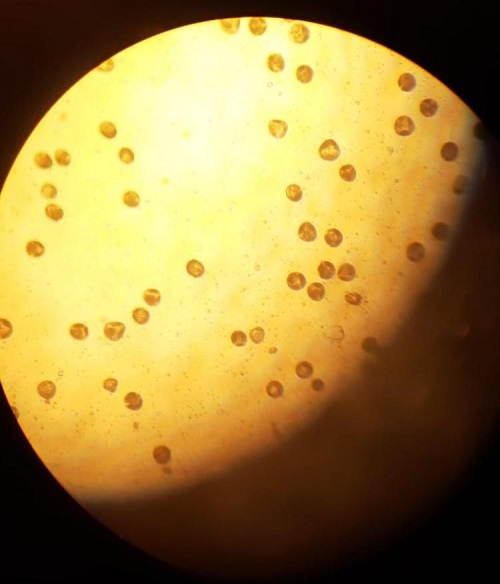
Diagnosis
Diagnosis of diarrhoea in animals based on the history and clinical symptoms can be easily says diarrhoea. Based on different diagnostic tools we can differentiate specific cause of diarrhoea. In young animals diarrhoea is more prone due to low immunity and suddenly not adopt to climatic, environment, nutritional change and poor management. Death may occurs due to the sever dehydration and shock.
- Based on clinical symptoms, such as loose faeces with mucus, without mucus, blood content present or absent, frequency, odour,volume of diarrhoea give as tentative diagnosis etiologicalagent. Diarrhoea with digested blood indicated of small intestine infection and diarrhoea with fresh blood indicated for large intestine infection.
- Any history of food poisoning.
- History of recent oral antibiotics therapy, it will predisposes to
- Isolation and identification of bacteria by diarrhoeal content such as E coli in EMB agar, Salmonellosis in Salmonella shigella agar.
- Faecal examination revealed the presence of parasitic ova and protozoal oocyst present in intestine confired on the basis of morphology of ova and oocyst.
- Pyrexia with enteritis indicated the infection origin.
- Diarrhoea with blood indicates enteritis.
|
Diarrhea |
Dysentery |
| Faeces is in voluminous fluid outcome | Faeces is scanty and sticky |
| No mucus in the faeces | Mucosal and fibrin shred in faeces |
| No blood in faeces | Blood in faeces |
| Less pus cells | Abundant pus cells observed |
| Less straining during defecation | Severe straining during defecation |
Treatment
- Removal of primary cause and stress.
- Systematic therapy should be given based on the cause of etiological agent such as antibiotics therapy for bacterial origin, antiprotozoal drugs for protozoal origin, anthelminthic therapy for the treatment of worm load infestation, antispasmodics therapy for nervous origin.
- To the non infectious origin, the animals should be treated symptomatically.
- Fluid therapy should be given for early recovery and recover from dehydration.
- Oral antidiarrheal drugs given for cause of unknown origin.
- Soft dietary supplements during diarrhoea.
- Oral rehydration therapy.
- Electrolytes supplementation.
Prevention and control measure
- Provide clean drinking water and maintain food hygiene.
- Avoid the sudden change in the dietary supplements to the farm animals.
- Avoid the animals to exposure of extreme weather and provide good hygiene in the farms.
- Clean shed should be provided.
- Isolation of healthy animal from diseased one in contiguous origin such as BVD, PPR.
- Avoid stress environment and transportation during the disease animals.
- Periodical health examination should be done
- Deworming should be done in regular basis to avoid the worm load infestation.
- Vaccination should be done like Bovine virus diarrhoea is controlled by vaccinating all replacement heifers 1 to 2 months before breeding. Animals may be vaccinated 6 weeks and 3 weeks before calving in Colibacillosis.
Reference
- Diarrhoea in adult cattle, Agriculture and food. August 2020
- Marck manual
- Diarrhoea in small ruminants. OSU.EDU. JUNE 2019
| The content of the articles are accurate and true to the best of the author’s knowledge. It is not meant to substitute for diagnosis, prognosis, treatment, prescription, or formal and individualized advice from a veterinary medical professional. Animals exhibiting signs and symptoms of distress should be seen by a veterinarian immediately |



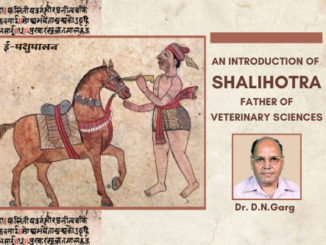
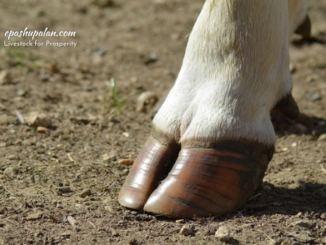
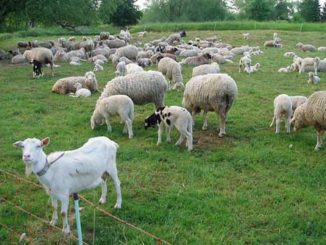

Nice information on diarrhoea
very informative